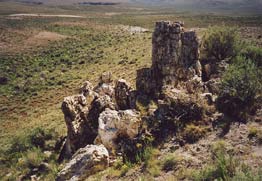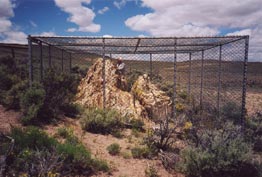
The Nell Tree (above) is one of the largest petrified
stumps in the George W. Lund Petrified Forest. Below, one of two large
trees next to Highway 34 caged for protection, with Howard Schorn for
scale. (photos by Diane Erwin)
|
|
 In the mid 1950s, Nell Murbarger set about to find a very large fossilized
redwood stump, which she had seen pictured in a paleobotany pamphlet.
Nell and her traveling companion Dora not only found this tree, butmany
others, which she wrote about in her Natural History Magazine article
“Our Largest Petrified Tree.” The identification of these trees
remained unresolved, some considering them to be Redwoods (Sequoia),
while others thought the trees produced the fossil leaf species, Metasequoia
langsdorfii, and therefore were Dawn Redwoods. Until now, no scientific
study of the forest had ever been done.
In the mid 1950s, Nell Murbarger set about to find a very large fossilized
redwood stump, which she had seen pictured in a paleobotany pamphlet.
Nell and her traveling companion Dora not only found this tree, butmany
others, which she wrote about in her Natural History Magazine article
“Our Largest Petrified Tree.” The identification of these trees
remained unresolved, some considering them to be Redwoods (Sequoia),
while others thought the trees produced the fossil leaf species, Metasequoia
langsdorfii, and therefore were Dawn Redwoods. Until now, no scientific
study of the forest had ever been done.
 Diane
Erwin and Howard Schorn spent time this summer with Constance
Millar, Robert Westfall, and John King (USDA Forest Service Pacific Southwest
Research Station) investigating these trees of the George W. Lund Petrified
Forest. Mapping revealed over 250 stumps buried in place by volcanic ash
fifteen million years ago. The wood and large size of some stumps suggest
Big Trees (Sequoiadendron) did grow in this ancient forest, their
fossilized remains a sobering reminder of the profound impact climate
change has on the success and distribution of organisms through time. Diane
Erwin and Howard Schorn spent time this summer with Constance
Millar, Robert Westfall, and John King (USDA Forest Service Pacific Southwest
Research Station) investigating these trees of the George W. Lund Petrified
Forest. Mapping revealed over 250 stumps buried in place by volcanic ash
fifteen million years ago. The wood and large size of some stumps suggest
Big Trees (Sequoiadendron) did grow in this ancient forest, their
fossilized remains a sobering reminder of the profound impact climate
change has on the success and distribution of organisms through time.
Focusing on Mammals
Tony Barnosky spent most of the summer in the Rocky Mountains
of Montana, Idaho, and Wyoming trapping small mammals. The first field
effort was led by Stanford University paleoecologist Liz Hadly and focused
on obtaining genetic samples for her efforts to model population genetics
through space and time in small mammal populations. Tony also joined
graduate students, Samantha Hopkins and Edward Davis, during part of
their field seasons.
 Samantha spent much of her summer traveling to museums in Washington, Kansas,
South Dakota, and Montana to study specimens associated with her thesis
research, the paleoecology of Miocene mammals form the Rocky Mountains.
After this time in the museums, however, Sam got out in
Samantha spent much of her summer traveling to museums in Washington, Kansas,
South Dakota, and Montana to study specimens associated with her thesis
research, the paleoecology of Miocene mammals form the Rocky Mountains.
After this time in the museums, however, Sam got out in

|

